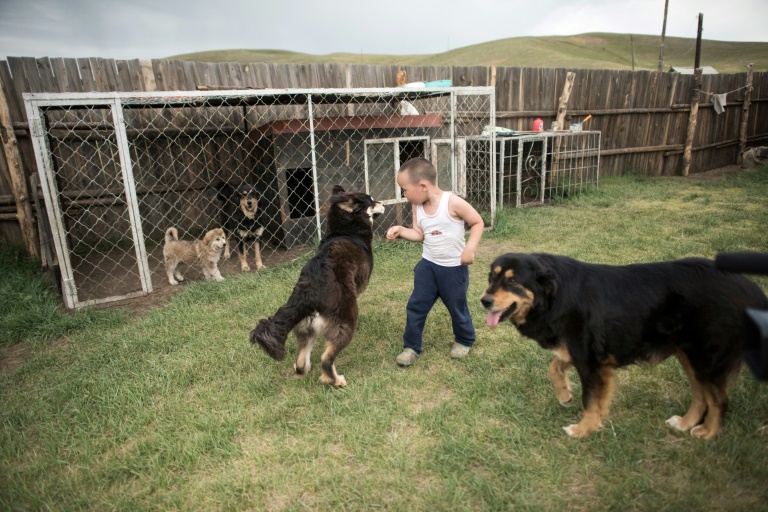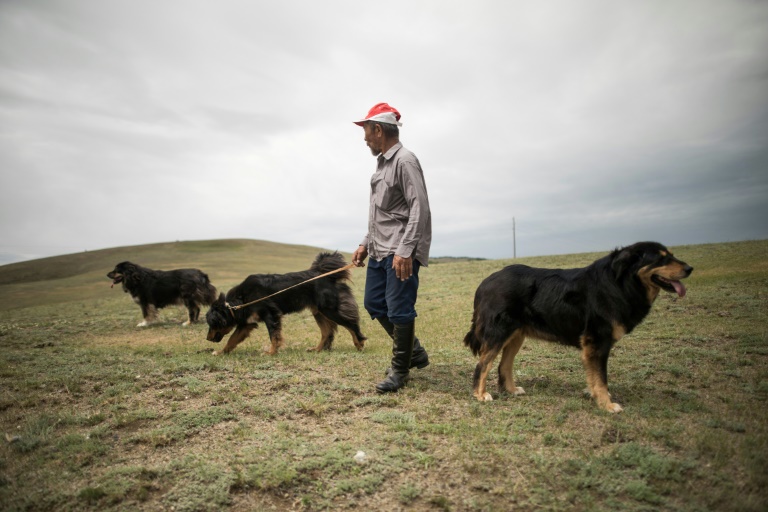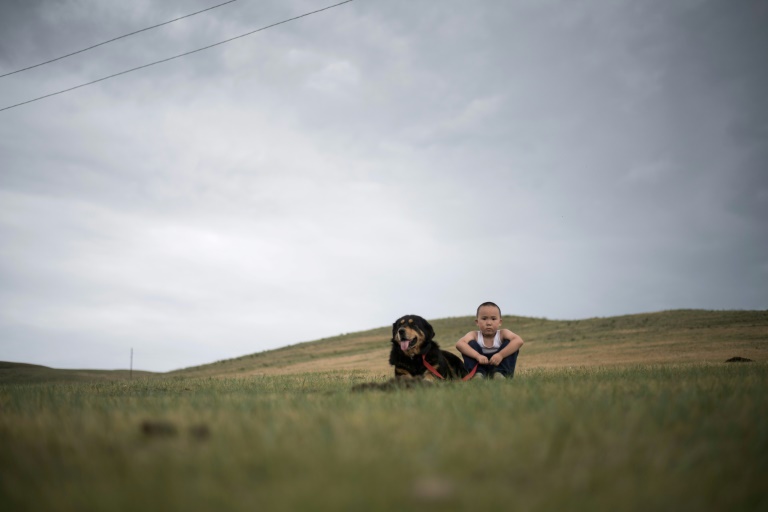Load shedding to be eased to stage 2 from 5am on Tuesday
Delgeriin Tserenkhand was a teenager when he saved the dog from the streets — only discovering later that his shaggy-haired pet belonged to one of the most ancient breeds in the world.
Now Delgeriin, 34, is part of a growing movement to revive the Mongolian bankhar, a rare herder dog steeped in nomadic traditions that almost died out during the country’s decades as a Soviet satellite state.
Though no reliable numbers exist on how many of these mostly black-haired “guardian” dogs remain, herders say there was a time, generations ago, that every Mongolian dog was a bankhar.

Delgeriin’s five-year-old son plays with Mongolian bankhars — rare herder dogs steeped in nomadic traditions that almost died out during the country’s decades as a Soviet satellite state
But a belief that the dog spread the plague resulted in widespread culls in the 1960s, as the bankhar’s assets — their herding abilities and significance according to Mongolian spiritual customs — were slowly forgotten.
“Saving the dogs means saving Mongolian culture,” Delgeriin told AFP at his ranch on the rolling steppes outside Ulan Bator.
Clad in a black T-shirt and a baseball cap bearing the emblem of the Mongolian Kynological Federation, of which he is president, Delgeriin commanded a pack of seven bankhars, each about the size of a small wolf.
Leashless, they bounded alongside him up a hill overlooking an open enclosure, answering to Mongolian names and turning their heads at Delgeriin’s every hand movement.
“Bankhars are very special,” the breeder said. “They’re comfortable around humans and livestock, but have a strong protective instinct when approached by predators.”
“Nomads are diminished without them,” said Delgeriin, who charges foreign buyers $2,000 per puppy but gives herders a discount.
– ‘Same spirit’ as humans –

When it was customary for every Mongolian family to own at least one bankhar, a nomad would treat sore joints by shaving off a tuft of the dog’s fur, soaking it in a bucket of oil and pressing it onto the aching area
When it was customary for every Mongolian family to own at least one bankhar, a nomad would treat sore joints by shaving off a tuft of the dog’s fur, soaking it in a bucket of oil and pressing it onto the aching area.
During droughts, nomads would place a sheet of wool on a bankhar to conjure up the rain.
Mongolians believe the dogs are distinct from other animals because they share the “same spirit” as humans, Delgeriin said. Dead bankhars are buried on top of a mountain to bring them closer to the gods.
A bankhar’s role is not merely spiritual: the Mongolian Bankhar Dog Project, a joint US-Mongolian initiative to reintegrate the animals into nomadic communities, has discovered that livestock losses to predators drop significantly with the dog’s presence.
When a herder family parks its yurt and livestock somewhere new, the dog will mark its territory and make itself known to surrounding predators.
“Bankhars can run quite fast, are heavier than Mongolian wolves and quite violent when it comes to another dog or snow leopard coming into its territory,” biologist Bruce Elfstrom, the non-profit’s founder, told AFP.
“One herder had lost 80 goats and sheep the year before he got a bankhar,” Elfstrom said. “The year after, he lost only 40. Another herder had lost 35, and none the year after.”
Elstrom’s team has collaborated with Cornell University scientists who found that the first domesticated dog likely originated in central Asia 15,000 years ago.
The research raises the possibility that bankhars, which have some of the highest genetic diversity in the world, are the closest relative to the original domesticated dog breed.
– The old pride –

Mongolians believe the dogs are distinct from other animals because they share the “same spirit” as humans
To demonstrate bankhars’ intelligence, Delgeriin likes to tell the story of a friend from the countryside who brought his dog to Ulan Bator.
Shortly after arriving in the city, the dog ran away, Delgeriin said, only to reappear a month later at the friend’s rural home more than 1,000 kilometres (620 miles) away.
The breed’s superior spatial memory helps bankhars guide livestock to the best areas for grazing.
Last spring, Elfstrom’s team visited a 68-year-old nomad who used to leave his livestock to graze at the bottom of a hill while he sat at the top watching them through a pair of binoculars.
After adopting a bankhar from Elfstrom’s project, however, the nomad began walking alongside his dog and livestock, moving them frequently to keep his grasslands flourishing.
“He fell in love with the dog, and the dog’s interest in the sheep caused him to change how he was herding,” Elfstrom said.
“This one dog got him feeling the old pride and tenderness of how he used to tend to stuff with his grandfather.”
Delgeriin, who also has a kennel in the city, hopes to expand his breeding centre to provide for more nomads.
His father-in-law helps him breed the dogs, while his five-year-old son walks them.
The breeder smiled as he watched his son prance confidently up a hill. The boy gripped a leash tied to a bankhar twice his size, holding fast to traditions spawned long before his time.
Download our app